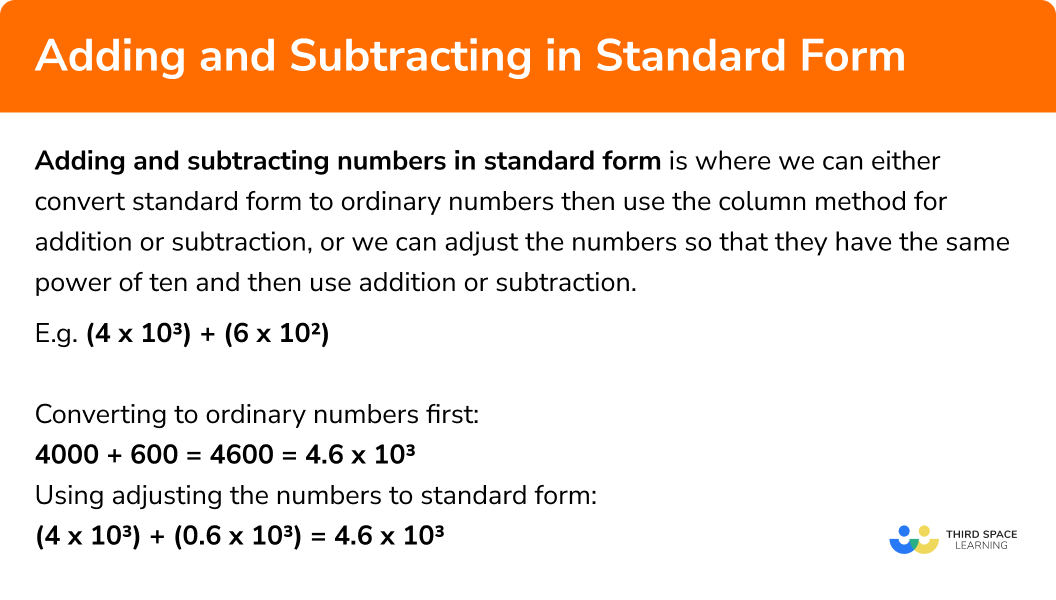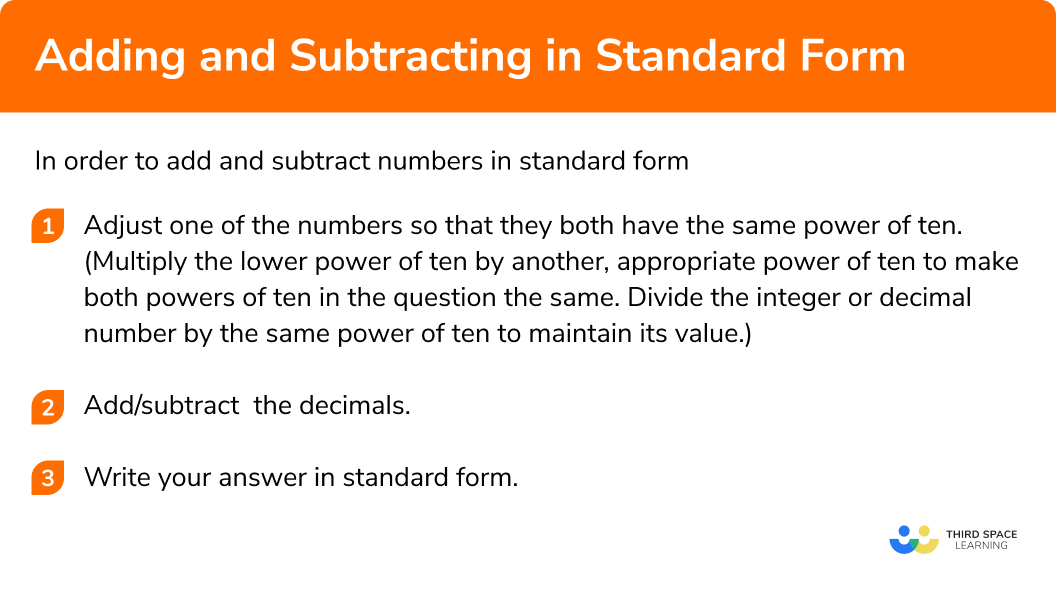GCSE Tutoring Programme
"Our chosen students improved 1.19 of a grade on average - 0.45 more than those who didn't have the tutoring."
In order to access this I need to be confident with:
Adding and subtracting decimals Multiplying and dividing decimals Laws of indices Negative numbers Place valueThis topic is relevant for:

Adding and Subtracting in Standard Form
Here we will learn about adding and subtracting numbers in standard form.
There are also adding and subtracting numbers in standard form worksheets based on Edexcel, AQA and OCR exam questions, along with further guidance on where to go next if you’re still stuck.
What is adding and subtracting in standard form?
Adding and subtracting in standard form works in a similar way to adding and subtracting ordinary numbers. There are two methods we can use.
We can either convert standard form to ordinary numbers then use the column method for addition or subtraction, or we can adjust the numbers so that they have the same power of ten and then use addition or subtraction.
E.g.
(4\times10^{3})+(6\times10^{2})
Converting to ordinary numbers first: 4000 + 600 = 4600
However, this method is not very efficient especially for very large and very small numbers.
To add and subtract numbers in standard we can first convert the numbers so that they have the same power of ten.
E.g.
Using standard form: (4\times10^{3})+(0.6\times10^{3})=(4.6\times10^{3})
What is adding and subtracting in standard form?

How to add and subtract with standard form
In order to add and subtract numbers in standard form:
- Convert one of the numbers so that both numbers have the same power of ten. Select the number with the lower power of 10.
- Add/subtract the decimals.
- Write your answer in standard form.
How to add and subtract with standard form


Adding and subtracting in standard form worksheet

Get your free adding and subtracting in standard form worksheet of 20+ questions and answers. Includes reasoning and applied questions.
DOWNLOAD FREE
Adding and subtracting in standard form worksheet

Get your free adding and subtracting in standard form worksheet of 20+ questions and answers. Includes reasoning and applied questions.
DOWNLOAD FREEAdding and subtracting standard form examples
Example 1: adding numbers in standard form
Work out:
- Convert one of the numbers so that both numbers have the same power of ten. Select the number with the lower power of 10.
10^{4} is the lowest power of ten. Multiply it by 10 so it also becomes 10^{5}
10^{4} x 1= 10^{5}
Divide
2 Add & subtract the decimals.
5 + 0.2 = 5.23 Write your answer in standard form.
( 5 x 10^{5}) + ( 0.2 x 10^{5}) = 5.2 x 10^{5}
Example 2: adding numbers in standard form
Work out:
Convert one of the numbers so that both numbers have the same power of ten. Select the number with the lower power of 10.
10^{-4} is the lowest power of ten. Multiply it by 10 so it also becomes 10^{-3}
Divide 6 by 10 to maintain the value.
Add/subtract the decimals.
Write your answer in standard form.
Example 3: adding numbers in standard form
Work out
Convert one of the numbers so that both numbers have the same power of ten. Select the number with the lower power of 10.
10^{5} is the lowest power of ten. Multiply it by 100 so it also becomes 10^{7}
Divide 2.5 by 100 to maintain the value.
Add/subtract the decimals.
Write 8.1 + 0.025 = 8.125
Write your answer in standard form.
Example 4: subtracting numbers in standard form
Calculate
Write your answer in standard form.
Convert one of the numbers so that both numbers have the same power of ten. Select the number with the lower power of 10.
10^{3} is the lowest power of ten. Multiply it by 10 so it also becomes 10^{4}
Divide 6 by 10 to maintain the value.
Add/subtract the decimals.
Write your answer in standard form.
Example 5: subtracting numbers in standard form
Calculate
Write your answer in standard form.
Convert one of the numbers so that both numbers have the same power of ten. Select the number with the lower power of 10.
10^{-3} is the lowest power of ten. Multiply it by 10 so it also becomes 10^{-2}
Divide 3 by 10 to maintain the value.
Add/subtract the decimals.
Write your answer in standard form.
Example 6: subtracting numbers in standard form
Calculate
Write your answer in standard form.
Convert one of the numbers so that both numbers have the same power of ten. Select the number with the lower power of 10.
10^{2} is the lowest power of ten. Multiply it by 100 so it also becomes 10^{4}
Divide 1.8 by 100 to maintain the value.
Add/subtract the decimals.
Write your answer in standard form.
Common misconceptions
- Using the column method
While this is not wrong, it is an inefficient method and can lead to errors when converting the numbers, especially with very large and very small numbers with many place holders.
E.g.
Work out (8\times10^{4})\quad+\quad(6\times10^{3})
Using standard form:
- Not converting solutions to standard form
After calculating with standard form, a common mistake is not ensuring the number is in standard form.
Remember to be in standard form the number needs to have two parts, the first part should between
E.g.
62\times10^{7} is not in standard form as
In standard for this should be written as 6.2\times10^{8}
- Negative powers
A common mistake is to become mixed up when using negative powers.
E.g.
10^{-3} is smaller than 10^{-2} because -3 is less than -2 .
10^{-3}=0.001 and 10^{-2}=0.01 so 10^{-2} is greater than 10^{-3}
Related lessons
Adding and subtracting standard form is part of our series of lessons to support revision on standard form. You may find it helpful to start with the main standard form lesson for a summary of what to expect, or use the step by step guides below for further detail on individual topics. Other lessons in this series include:
Practice adding standard form and subtracting standard form questions
1. Work out (2\times10^{6})\quad+\quad(3\times10^{5}) . Write your answer in standard form




2. Work out (4\times10^{-5})\quad+\quad(7\times10^{-6}) . Write your answer in standard form.




3. Work out (6.4\times10^{8})\quad+\quad(3.5\times10^{6}) . Write your answer in standard form.




4. Work out (7\times10^{4})\quad-\quad(4\times10^{3}) . Write your answer in standard form.




5. Work out (5\times10^{-3})\quad-\quad(2\times10^{-4}) . Write your answer in standard form




6. Work out (7.8\times10^{5})\quad-\quad(2.3\times10^{3}) . Write your answer in standard form.




Adding and subtracting standard form GCSE questions
1. The table below shows the population of several cities
| City | Population |
| London | 8.9 x 10^6 |
| Manchester | 5.5 x 10^5 |
| Birmingham | 1.1 x 10^6 |
| Oxford | 1.1 x 10^5 |
Work out the total population of London and Manchester. Give your answer in standard form.
(3 marks)
Simplifying by writing the two populations as an ordinary number:
London: 8900000
Manchester: 550000
OR
converting 5.5\times10^{5} to 0.55\times10^{6}
(1)
Adding the numbers:
8900000 + 550000 = 9450000
OR
8.9\times10^{6} +0.55\times10^{6} = 9.45 \times 10^{6}(1)
9.45 \times 10^{6}(1)
2. Work out 7\times10^{6}\quad-\quad4\times10^{5} .
Give your answer in standard form.
(3 marks)
Simplifying by writing the two numbers as an ordinary numbers:
7000000 – 400000OR
converting 4\times10^{5} to 0.4\times10^{6}
(1)
Subtracting the numbers:
7000000 – 400000 = 6600000
OR
7\times10^{6} – 0.4\times10^{6} = 6.6 \times 10^{6}(1)
6.6\times10^{6}(1)
3. Show that
2.4\times10^{2}\quad+\quad3.7\times10^{3}\quad=\quad3.94\times10^{3}
(2 marks)
240 + 3700 or 0.24\times10^{3} or 39.4\times10^{2}
(1)
Correct working shown
(1)
Learning checklist
You have now learned how to:
-
Add numbers in standard form
-
Subtract numbers in standard form
The next lessons are
Still stuck?
Prepare your KS4 students for maths GCSEs success with Third Space Learning. Weekly online one to one GCSE maths revision lessons delivered by expert maths tutors.

Find out more about our GCSE maths tuition programme.